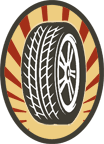
Sadly, the term “All Season” doesn’t apply to Ontario winters, when traction matters most.
So what’s the difference, anyway?
Two things. First, winter tires have specially designed tread that allows them dig into snow and grab ice better when taking off and stopping, and also clear away snow and slush when moving. Second, they are made with a special rubber compound designed to remain ‘sticky’ at temperatures below freezing.
What does temperature have to do with it?
Tire rubber is temperature sensitive. To provide proper traction it must remain flexible, so that the tread can properly bite and stick to the road surface. While rubber compounds can be designed to operate in wide temperature ranges, there is no one compound that works well at all temperatures, especially those below zero.
Okay, but do they really make a difference?
Absolutely, and you will notice it. If you’ve never used winter tires, find someone who does and ask them. Better yet, ask them to take their car around the block. Less spinning out when trying to get moving, fewer stops with ABS activation, and over twenty percent shorter stopping distance in panic stops. The difference in traction is significant and many of the troublesome aspects of winter driving are improved.
If they are so great, why not run them all year?
Back to temperature. Winter tires are too soft to run in summer temperatures and will wear out quickly.
Can I get away with just two on the front?
Possibly, but in doing so you lose much of the benefit and compromise safety. Winter tires on the front will improve traction during take off and make steering and simple stops somewhat easier, but the also they make the vehicle fundamentally unbalanced. This may not be immediately obvious, but during a sudden stop, when taking a curve a little too fast, or in very slippery conditions, it can become very apparent very quickly. Under these conditions, the front will tend to ‘stick’ and the rear won’t, which can result in fish-tailing and spinning out altogether. This potential is made worse by the confidence that front snow tires can give during take off. For best safety and performance, Transport Canada recommends four snow tires of the same make. For a demonstration for how mis-matched tires affect handling, check out this series of videos by Transport Canada – Winter Tire Demonstration
When should I install them?
A good rule of thumb is to install your winter tires in the fall and remove them in the spring when the daily temperature averages about ten degrees Celsius.
